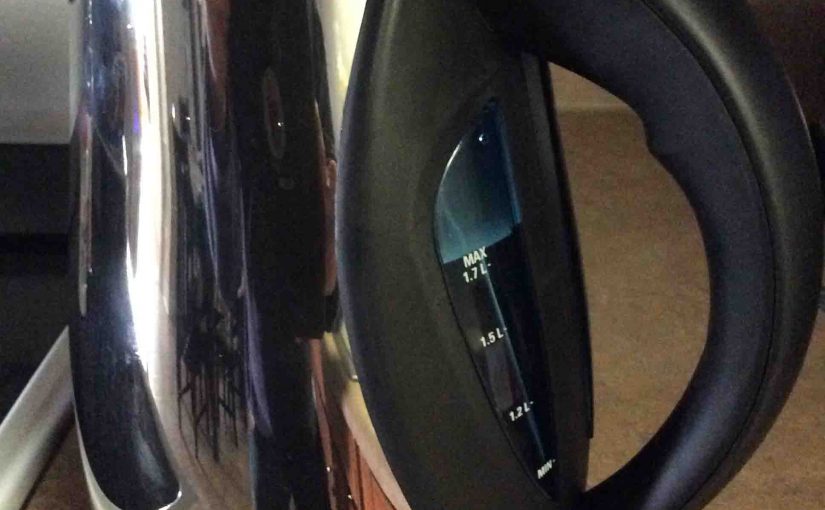When cleaning tea kettle with vinegar, we’ve heated gallons upon gallons of hard and soft water for tea and hot cocoa making, with our Hamilton Beach tea kettle. In this post, we show how to clean tea kettle with vinegar. We’ve cleaned ours successfully many times. We also discuss how to keep the tea kettle clean in the first place.
We’ve found that without routine cleaning, metal kettles can get brown or white stains. This happens a lot when you brew the tea directly in it after the water boils. That unsightliness can be hard to remove. So, wanting to keep that shiny, new look as long as possible, we looked for ways that would keep our tea kettle spiffy. The tips listed next, we’ve found work quite well.
Cleaning Tea Kettle with Vinegar: Keep it Clean to Start With
With minimal periodic cleaning, powered kettles, since they’re metal and / or glass, are easy to keep tea stain free. Your first strategy against hard water build up? Do not allow them to build up in the first place. Clean your electric tea kettle after every use. Make sure to unplug it first of course. Don’t let any beverage dry inside.
Regular dish detergent (for the sink, not the dishwasher) works well for general purpose and mild stain cleaning.
But if your kettle still smells of tea after cleaning than you did not clean it well enough. So, repeat the steps again. Your kettle may need several tries, or a stronger soap too.
You can also try baking soda, lemon juice, vinegar, or citric acid, to effect serious descaling and odor removal.
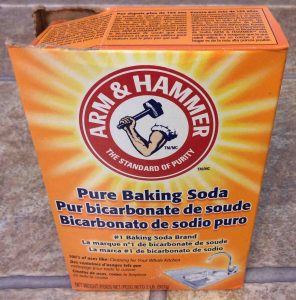
In the very worst cases of stubborn calcium deposits, we suggest trying Lime-A-Way. This is a very harsh hard water deposit remover. So we only apply it as a last resort.
Further, do not use this cleaner unless the tea kettle’s instruction manual says that it is safe. Even then, put a drop on a hidden area. Then, wait a few minutes to see if the area changes color, grows rough, or shows other damage signs. If so, do not use Lime-A-Way.
Follow Users Guide Instructions for Cleaning Tea Kettle with Vinegar
Most tea kettles come with an owners guide, with detailed cleaning procedures. First and most importantly, follow them, as the manufacturer probably knows best how to clean their kettles effectively. Their tips and advice, in all circumstances, supersede any tips offered here. Many recommend nothing stronger than a squeeze of dish detergent. Do not worry about this creating an aftertaste. It will not if you rinse the tea kettle and parts well.
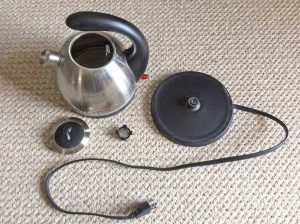
The picture above displays a typical tea kettle, completely taken apart. We have the lid, strainer, kettle stand with power cord, and the kettle itself. Clean each piece with the right cleaners. Plus, handle the pieces carefully while you work. We discuss in detail below.
Avoid Scratching and Rubbing Too Hard
Stainless steel finishes resist staining as long as you do not scratch or mar them. So avoid scouring with any rough cleansers, gritty pot scrubbers, steel wool pads, and bathtub cleaners. Avoid any metal scrubbers, such as wire brushes or burnishing tools. Even plastic or Nylon scrubbers can scratch and rub off finishes. So use them sparingly on stainless steel, chrome, and plastic parts. Save these for the really tough stains, and rely primarily on your dishcloth for routine cleanup.
Throw Out that Old Beverage
Also, keep your tea kettle clean by discarding unwanted, unused beverages right away. Best not to let hot drink stand in the kettle for long. Doing so can “bake in” that pesky yellow-brown color.
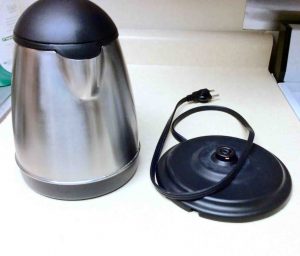
How to Clean Tea Kettle with Vinegar?
For those stubborn stains that dish soap does not lift, try deep cleaning the kettle. How? Run a pot of half water and half white vinegar through the heating cycle. If your water is hard, use distilled water to help maximize removal of the hard water deposits. Cycling through with all parts attached cleans it all.
When this does not fully clean, remove the lid and spout strainer. Soak these in a sink or bucket filled with hot vinegar water (half and half). Allow them to marinate for several hours. Then check them every hour or so, to see if descaling is happening.
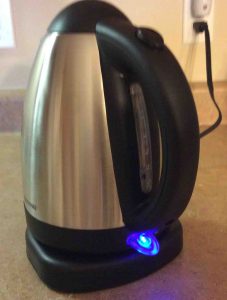
General Cautions and Warnings for Cleaning Tea Kettle with Vinegar
Disconnect the power before cleaning. Even in cordless electric teakettles, water and electricity do not mix. Otherwise, you could receive an injurious electric shock.
Also, do not immerse any parts of the kettle unless they’re submersible. You can dunk lids and strainers. But keep the kettle itself and the stand out of the water. Just fill the kettle with the cleaner. Then, let it mellow until clean. Wipe the stand with a damp soapy cloth. Then wipe it again with a clean rinsed cloth. Soak the spout strainer and lid in the sink if these become too soiled.
Note that procedures that work well for an aluminum vessel may be inappropriate for a stainless steel teakettle. So, apply the right techniques to your particular kettle. Again, consult its users manual for appropriate cleaning tips and advice.
No harsh chemicals. Avoid using acids, drain cleaners, and any strong smelling or fumy compounds. They can damage or even soften any plastic components (handles, knobs, Etc.). Plus, solvents can discolor the stainless steel finish and dull its shine.
When small amounts of vinegar do not work, heat a full-strength load in their tea kettles. This often works better than the half-and-half solution with water for thick deposits. When you have lots of scale and other hard water deposits, try strong vinegar. While this probably will not harm the teakettle, it smells horrific! If you must boil undiluted vinegar, place your kettle outside. Then, let it boil there, where the moving air will carry away that sour vinegar odor.
Related Posts to Cleaning Tea Kettle with Vinegar
- How to Clean Stainless Steel Electric Percolators
- Cleaning Anti Reflex Eyeglasses, How To
- Chef’s Choice Cordless Tea Kettle 677-2 Review
- How to Clean an Electric Kettle Safely
- Cleaning a Cordless Electric Kettle, How To
References for Cleaning Tea Kettle with Vinegar
- Cleaning a Kettle Tips from Cleanipedia
- How to Clean a Tea Kettle from Top Cleaning Secrets
- Removing Hard Water Build-Up-A Quick Guide from Best Electric Kettles
Revision History
- 2019-04-15: Added tags and removed ad code.
- 2018-04-16: Originally published.
